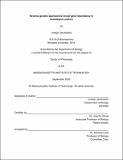Reverse genetic approaches reveal gene redundancy in Arabidopsis anthers
Author(s)
Jacobowitz, Joseph(Joseph R.)
Download1227031226-MIT.pdf (32.13Mb)
Other Contributors
Massachusetts Institute of Technology. Department of Biology.
Advisor
Jing-Ke Weng.
Terms of use
Metadata
Show full item recordAbstract
When aquatic plants migrated to land 500 million years ago, they were met with harsh conditions associated with terrestrial life, such as dry air, high radiance light, and high effective gravity. Early plants of this time period underwent rapid evolution to develop novel plant traits to mitigate these challenges - these traits remain highly conserved in modern land plants. Among the most important of these traits is the biosynthesis of a unique polymer known as sporopollenin, which protects the vulnerable plant spore and pollen grain. Sporopollenin is considered to be the toughest known biopolymer and although chemists and botanists have studied this remarkable material for over a century, relatively little is known about sporopollenin compared to other major plant biopolymers. In this thesis, I employ reverse genetic approaches to identify novel Arabidopsis genes that are responsible for sporopollenin biosynthesis. With these methods, I identify a previously unstudied gene, hereby known as IPE2 , which acts redundantly with IPE1 in the synthesis of sporopollenin. Additionally, I identify two unstudied peroxidases, PRX9 and PRX40 , which are also redundant and critical for pollen development, although these are not involved in sporopollenin and instead crosslink cell wall extensin proteins. These works enhance our understanding of the pollen wall and of pollen development. Moreover, this work reveals the untapped potential of reverse genetics to predict redundant relationships between paralogs in well-studied model organisms.
Description
Thesis: Ph. D., Massachusetts Institute of Technology, Department of Biology, 2020 Cataloged from student-submitted PDF of thesis. Includes bibliographical references.
Date issued
2020Department
Massachusetts Institute of Technology. Department of BiologyPublisher
Massachusetts Institute of Technology
Keywords
Biology.